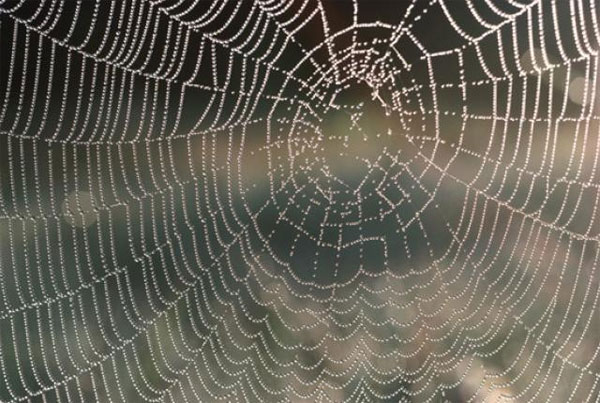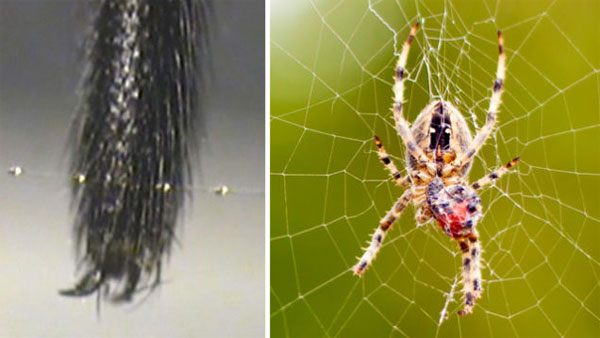The truth about how spiders move about on a spider web
Spiders have a special trick that helps them move easily on glue-like filaments on their webs.
Spider web is a very useful trap of spiders, any insect or caterpillar will fall into this trap, they will immediately get caught but cannot escape. However, the spider itself has the most time to interact with spider webs, but they are not affected by their trap.
In fact spider web is made up of two types of silk. A thick and non-sticky silk acts like the frame of a spider web. A thinner silk with glue-like liquid drops used to catch prey. The spiders knew very well about their trap, also capable of distinguishing the types of silk that they could move on non-stick silk threads. However, they cannot always avoid sticky fibers, especially when catching prey that has fallen into a trap. So what keeps them from sticking to their threads?

For a long time, people thought that spiders were not attached to their networks because their legs were covered with a special oil , secreted from inside the body. Some scientists' experiments when washing the legs of spiders, as a result, they can be attached to their own threads. However, sometimes they can still move normally. This shows that in addition to the special oil on the legs, there are other reasons that spiders can easily move on spider webs without being sticky.
In a recent study by Dr. Dr. William Eberhard and Daniel Briceño (two Costa Rican biologists), by filming with a microscope how to move spiders on a spider web, two scientists discovered how spiders use to not stick when moving on their own threads.
In their experiment, two scientists observed how they moved on the spider web with a microscope. They found that the spiders moved very carefully on the fibers with binder. They have a special way of reducing the contact between the legs and the droplets on the fibers, they call it the third claw approach .

As they move on the spider web, they will use their third claw to grab the silk thread and press it into the inner fluff on their feet. It is these soft fluff fibers that are very good at sticking to silk fibers, in part because they are so small that the area of contact with adhesives is very small, besides these fluffy fibers themselves are covered. Covered with a special non-stick oil.
Researchers have yet to find out whether this particular anti-stick substance comes from the beginning, but through the action of the spiders they judge that the substance is secreted from the spiders' mouths. When Briceño and Eberhard wash the spiders' legs and watch, they see them as licking their own legs so they can move on the spider web. Scientists are also studying the composition of this special non-stick agent, to apply to the non-stick, dust-proof surfaces of humans.
Thus, if a spider for some reason gets stuck in another part of the body, but not the fluff on its feet, it will be difficult for them to escape. Having spiders after falling into the spider web of another spider has become a good prey.

However, there is a special spider that hunts other spiders on their own trap, which is the Portia spider . This particular spider will jump straight into a trap of another spider, then it pretends to vibrate the network like a prey trap signal. After deceiving the 'host' spider, Portia will finish it off with her venom and have a good meal. However, they can change tactics and escape quickly when unfortunately encounter larger and more aggressive spiders.
In fact, spider silk is a material that has very good strength and resistance, so many spiders can catch both small birds or bats flying with their webs. Darwin's black spider in Madagascar has the ability to create giant spider webs up to 24m in length. However, if you talk about the spider's largest network, it must include the society of Guatemalan longan spider . In August 2007, one of the largest spiders found in the East Texas state park. These spiders form a network of cobwebs, stretching up to 180 meters and covering the branches.
- 10 poisonous spiders are the most feared for humans
- Science has proven: Spider is a friend, not an enemy!
- Startled at 5 giant spider species in the world
- What if we swallow a spider?
- Spiders have a horror ability that new scientific hours have discovered
- Detecting eyeless spiders
- Identify spiders through software
- Spiders can also spread silk in the universe
- Incredibly spider species die because of ...
- New research: Spiders can use electricity to fly in the air
- Why so little bigger spiders male spiders?
- Tiny spiders suck the souls of their partners with a fan dance
 'Fine laughs' - Scary and painful torture in ancient times
'Fine laughs' - Scary and painful torture in ancient times The sequence of numbers 142857 of the Egyptian pyramids is known as the strangest number in the world - Why?
The sequence of numbers 142857 of the Egyptian pyramids is known as the strangest number in the world - Why? History of the iron
History of the iron What is alum?
What is alum?